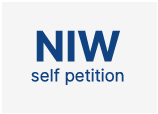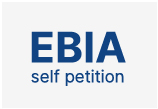This website uses cookies so that we can provide you with the best user experience possible. Cookie information is stored in your browser and performs functions such as recognising you when you return to our website and helping our team to understand which sections of the website you find most interesting and useful.
EB1A / EB2-NIW Application Process
The application process for E11 or EB1A is similar to EB2-NIW. Unlike several other employment based applications, these self-petition categories do not require labor certification. The application process consists primarily of two stages. The first stage involves the I-140 application, petition for permanent residency where USCIS decides if you are eligible to get a green card. The second stage involves I-485 application for adjustment of status to a permanent resident. These are described in detail below. In addition to these two applications, there are few other companion applications which applicants may decide to use depending on their situation.
The key difference between EB1A and EB2-NIW is the petition associated with i-140 application. In addition, it may help to mail an ETA-9089 form along with I-140 EB2-NIW application. Rest of the process is the same.
Two stages:
- I-140 application: This application is used to petition for an alien worker to become a permanent resident in the United States. This is the main petition where you would include all the evidence detailing why you think are eligible to become a permanent resident of the United States. Primary applicant files this application and can include names of his/her family members on this application. In the case of self-petitions, the date of application of I-140 application is called priority date. There are no visa requirements for I-140 application. Please see this link for more details.
- I-485 application: The purpose of this application is to adjust your status and register in the US as a permanent resident. Every year USCIS is allowed to grant up to a fixed number of immigration visas. Due to restriction on numbers, USCIS only accepts applications if the priority dates are current. Department of justice (DOJ) determines the current priority dates based on category of application (EB1, EB2 etc) and nationality. These are released every month as part of a visa bulletin. While the priority dates may sound confusing, they are actually easy to understand with an example. If you are from a country other than India or China, you would notice in March 2013 visa bulletin that priority dates are current for EB1 and EB2. So you are allowed to apply I-485 anytime. You can apply I-140 and I-485 together (concurrent filing) or one after the other (separate filing). If you are from China, you are allowed to file I-485 if your I-140 was filed on or prior to 15 Feb 2008. One I-485 application is filed for each family member (spouse and children are derivative applicants of the primary applicant). All applicants can enjoy the benefits of EAD and AP.
Other useful applications:
- I-765 application: If you have applied or applying a I-485 you can apply for an employment authorization document (EAD). EAD allows you to work while i-485 is pending.
- I-131 application: If you have applied or applying a I-485 you can apply for an advanced parole (AP). AP allows you to travel abroad without a visa while i-485 is pending.
Our petition packets include I-140 petition, cover letter for I-485 and example filled forms I-485, I-131 and I-765 for a representative case.
EB1A /EB2-NIW I-140 check list
- I-140 application checklist I-140 application and fee. You can check the latest fee on the USCIS website. Instructions for paying fee can be found at this USCIS link.
- If filing in the NIW category please include a filled copy of ETA-9089 to the USCIS.
- Petition letter.Detailted letter explaining your evidence to the USCIS officer.
- Reference letters, CV and various other evidence.
Disclaimer: The contents in this web site are only for your information and are not intended to be legal advice. While many of our applicants successfully obtain their I-140 approvals, the information here should not be considered as a guarantee of your green card application outcome.




